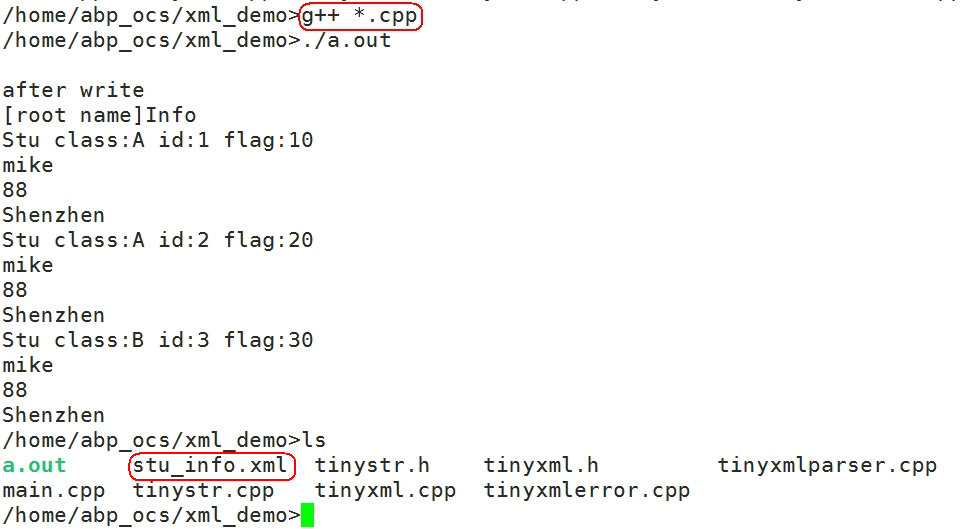C++通過TinyXML類庫讀寫XML檔案
阿新 • • 發佈:2019-02-07
TinyXML是一個開源的解析XML的解析庫,能夠用於C++,能夠在Windows或Linux中編譯。這個解析庫的模型通過解析XML檔案,然後在記憶體中生成DOM模型,從而讓我們很方便的遍歷這棵XML樹。
DOM模型即文件物件模型,是將整個文件分成多個元素(如書、章、節、段等),並利用樹型結構表示這些元素之間的順序關係以及巢狀包含關係。
然後解壓縮TinyXML後,將這六個檔案新增到你的c++工程中,分別是tinystr.h、tinystr.cpp、tinyxml.h、tinyxml.cpp、tinyxmlerror.cpp、tinyxmlparser.cpp。
如本示例中,只有 main.cpp 才是測試程式碼:
編寫程式碼時,只需要包含 tinyxml.h 標頭檔案即可,但是,編譯時卻需要把所有.cpp 檔案都加上。
示例程式碼如下:
#include <stdio.h> #include "tinyxml.h" #include <iostream> #include <cstring> using namespace std; /* TiXmlDocument:文件類,它代表了整個xml檔案 TiXmlDeclaration:宣告類,它表示檔案的宣告部分 TiXmlComment:註釋類,它表示檔案的註釋部分 TiXmlElement:元素類,它是檔案的主要部分,並且支援巢狀結構,一般使用這種結構來分類的儲存資訊,它可以包含屬性類和文字類 TiXmlAttribute/TiXmlAttributeSet:元素屬性,它一般巢狀在元素中,用於記錄此元素的一些屬性 TiXmlText:文字物件,它巢狀在某個元素內部 */ //建立xml檔案 int writeXmlFile() { TiXmlDocument *writeDoc = new TiXmlDocument; //xml文件指標 //文件格式宣告 TiXmlDeclaration *decl = new TiXmlDeclaration("1.0", "UTF-8", "yes"); writeDoc->LinkEndChild(decl); //寫入文件 int n = 3; //父節點個數 TiXmlElement *RootElement = new TiXmlElement("Info");//根元素 RootElement->SetAttribute("num", n); //屬性 writeDoc->LinkEndChild(RootElement); for(int i=0; i<n; i++)//n個父節點 { TiXmlElement *StuElement = new TiXmlElement("Stu");//Stu //設定屬性 StuElement->SetAttribute("class","A"); if(2 == i) { StuElement->SetAttribute("class","B"); } StuElement->SetAttribute("id",i+1); StuElement->SetAttribute("flag", (i+1)*10); RootElement->LinkEndChild(StuElement);//父節點寫入文件 //姓名 TiXmlElement *nameElement = new TiXmlElement("name"); StuElement->LinkEndChild(nameElement); TiXmlText *nameContent = new TiXmlText("mike"); nameElement->LinkEndChild(nameContent); //分數 TiXmlElement *scoreElement = new TiXmlElement("score"); StuElement->LinkEndChild(scoreElement); TiXmlText *scoreContent = new TiXmlText("88"); scoreElement->LinkEndChild(scoreContent); //城市 TiXmlElement *cityElement = new TiXmlElement("city"); StuElement->LinkEndChild(cityElement); TiXmlText *cityContent = new TiXmlText("Shenzhen"); cityElement->LinkEndChild(cityContent); } writeDoc->SaveFile("stu_info.xml"); delete writeDoc; return 1; } //解析xml檔案 int readXmlFile() { TiXmlDocument mydoc("stu_info.xml");//xml文件物件 bool loadOk=mydoc.LoadFile();//載入文件 if(!loadOk) { cout<<"could not load the test file.Error:"<<mydoc.ErrorDesc()<<endl; exit(1); } TiXmlElement *RootElement=mydoc.RootElement(); //根元素, Info cout<< "[root name]" << RootElement->Value() <<"\n"; TiXmlElement *pEle=RootElement; //遍歷該結點 for(TiXmlElement *StuElement = pEle->FirstChildElement();//第一個子元素 StuElement != NULL; StuElement = StuElement->NextSiblingElement())//下一個兄弟元素 { // StuElement->Value() 節點名稱 cout<< StuElement->Value() <<" "; TiXmlAttribute *pAttr=StuElement->FirstAttribute();//第一個屬性 while( NULL != pAttr) //輸出所有屬性 { cout<<pAttr->Name()<<":"<<pAttr->Value()<<" "; pAttr=pAttr->Next(); } cout<<endl; //輸出子元素的值 for(TiXmlElement *sonElement=StuElement->FirstChildElement(); sonElement; sonElement=sonElement->NextSiblingElement()) { cout<<sonElement->FirstChild()->Value()<<endl; } } return 1; } int main(int argc, char *argv[]) { writeXmlFile(); printf("\nafter write\n"); readXmlFile(); return 0; }
編譯執行結果如下:
生成的xml檔案內容如下:
<?xml version="1.0" encoding="UTF-8" standalone="yes" ?> <Info num="3"> <Stu class="A" id="1" flag="10"> <name>mike</name> <score>88</score> <city>Shenzhen</city> </Stu> <Stu class="A" id="2" flag="20"> <name>mike</name> <score>88</score> <city>Shenzhen</city> </Stu> <Stu class="B" id="3" flag="30"> <name>mike</name> <score>88</score> <city>Shenzhen</city> </Stu> </Info>



